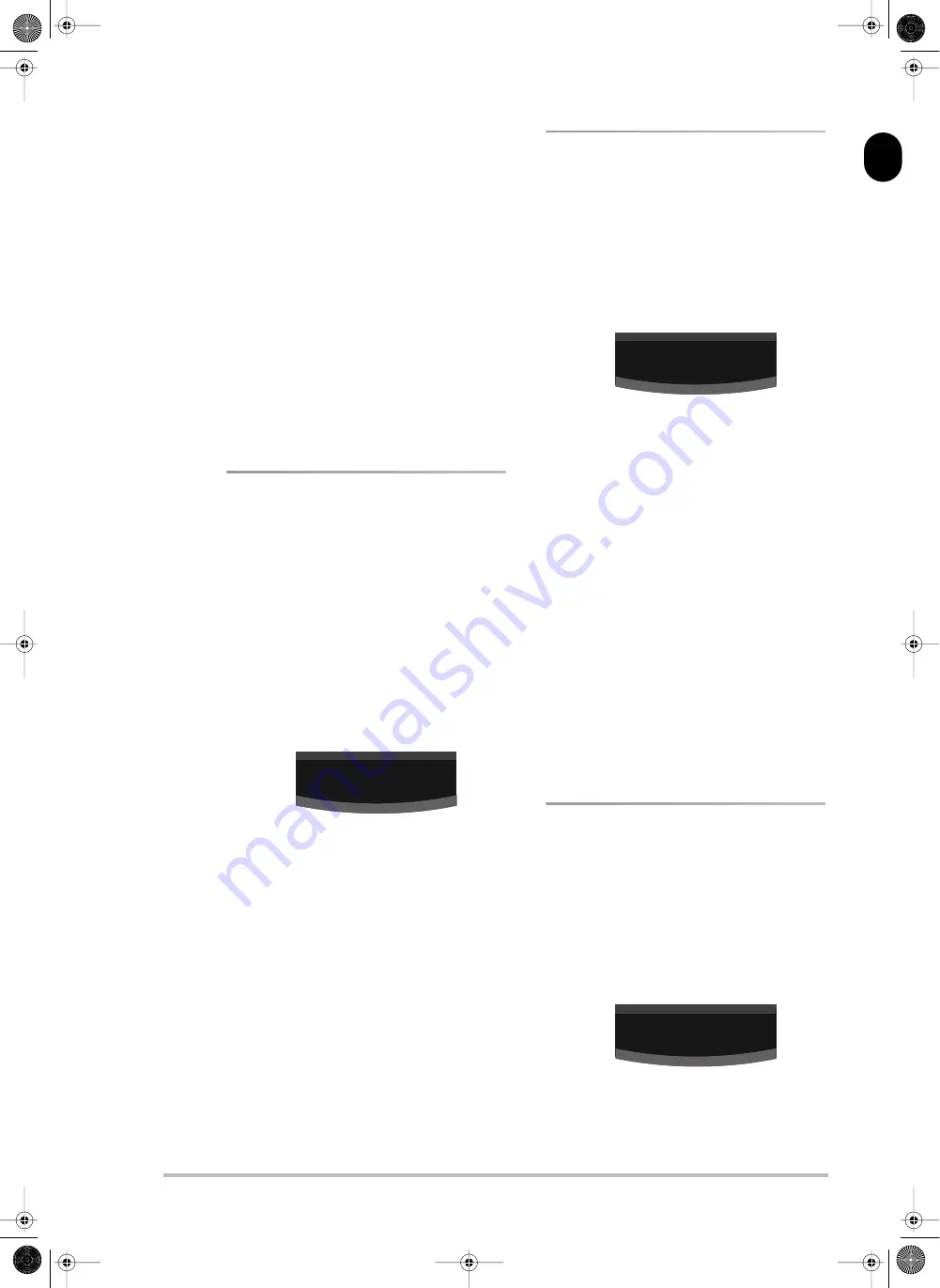
Owner’s Manual
25
[ENTER]
to confirm your setting will immediately
take you to
[6]
, where you can enter the value for
CC32 tr
.
When you confirm that value by pressing
[ENTER]
,
you can enter the Program Change number. (There
is thus no real need to press
[6]
or
[7]
to select the
CC32
or
Pr9Ch
parameters.)
As soon as you confirm the
Pr9Ch
value (by press-
ing
[ENTER]
), the memory selection cluster is trans-
mitted.
Use
[DEC÷NO]
/
[INC÷YES]
to specify the bank and pro-
gram change numbers.
Note:
While the setting range for CC00 and CC32 is 0~127,
that of the
Pr9Ch
parameter is 1~128.
Note:
You can also select
off
for these three parameters to
prevent the part in question from sending that message.
Note:
If
Pr9Ch
is set to
off
, the CC00 and CC32 values are
not transmitted (CC00/CC32 must always be followed by a
Program Change number).
Transmitting Volume values
→
[MIDI]
This parameter allows you to specify the volume
value (CC07) to be transmitted by the Upper and/or
Lower part whenever you select the Setup memory
that contains this setting. That way, the MIDI instru-
ment you are controlling is automatically set to the
desired level.
The setting range is 0~127, Off. Remember that
selecting “0” silences the receiving MIDI instrument.
Note:
You can also set the volume of external MIDI instru-
ments in realtime – using the PART LEVEL
[UPPER]
and
[LOWER]
sliders.
(1) Press
[EDIT]
(lights), followed by
[8]
.
Press and hold
[8]
to display the abbreviated
function name.
(2) Press the
[UPPER]
(red) or
[LOWER]
(green)
button to select the part whose setting you
want to change.
(3) Use
[DEC÷NO]
/
[INC÷YES]
to set the volume
value (0~127). Simultaneously press
[DEC÷NO]
and
[INC÷YES]
to select
off
if the selected
part should not transmit any CC07 value
when you select the Setup memory in ques-
tion (this is the default setting).
(4) Press
[EXIT]
(or
[EDIT]
) to leave the Edit mode
or select the other part and change its setting
too.
Note:
This setting can be saved (see p. 28).
Reverb Send level
→
[MIDI]
This parameter allows you to specify the Reverb
Send Level value (CC91) to be transmitted by the
Upper and/or Lower part whenever you select the
Setup memory that contains this setting. The setting
range is 0~127, Off.
Selecting “0” will set the receiving MIDI instrument
to “dry” (no Reverb), while “127” represents the
maximum Reverb Send level.
(1) Press
[EDIT]
(lights), followed by
[VARIATION]
.
Press and hold
[VARIATION]
to display the
abbreviated function name.
(2) Press the
[UPPER]
(red) or
[LOWER]
(green)
button to select the part whose setting you
want to change.
(3) Use
[DEC÷NO]
/
[INC÷YES]
to set the send level
value (0~127). Simultaneously press
[DEC÷NO]
and
[INC÷YES]
to select
off
if the selected
part should not transmit any CC91 value
when you select the Setup memory in ques-
tion (this is the default setting).
(4) Press
[EXIT]
(or
[EDIT]
) to leave the Edit mode
or select the other part and change its setting
too.
Note:
This setting can be saved (see p. 28).
Note:
If there is no audible change, you may have to
check the Reverb effect settings on the receiving MIDI
instrument.
Note:
Not all MIDI instruments have a Reverb effect
and even if they do, they may not support this control
change number (this is especially true of older instru-
ments).
Chorus Send level
→
[MIDI]
This parameter allows you to specify the Chorus
Send Level value (CC93) to be transmitted by the
Upper and/or Lower part whenever you select the
Setup memory that contains this setting. The setting
range is 0~127, Off.
Selecting “0” will set the receiving MIDI instrument
to “dry” (no Chorus), while “127” represents the
maximum Chorus Send level.
(1) Press
[EDIT]
(lights), followed by
[9]
.
Press and hold
[9]
to display the abbreviated
function name.
off
vOlume tr
off
reuerb tr
off
chOrus tr
RD-170 OM_GB Page 25 Monday, March 17, 2003 10:23 AM


























